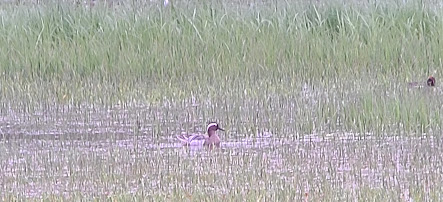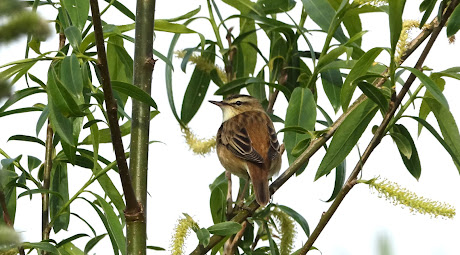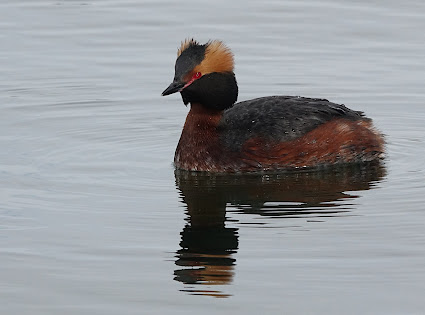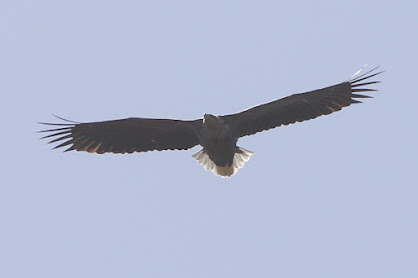
I co-led a Wildlife Travel trip to Estonia the week before last, with Heleria Alles from NaTourEst. We had a really enjoyable week in the west of the country, half the time on the large island of Saaremaa and the rest in and around Matsalu National Park. The spring is much later in Estonia than the UK, with the countryside still looking very wintry, apart from woodland flowers, such as Liverleaf, Winter Aconites and Lesser Celandines. The weather was cold, with some snow showers and a lot of northerly wind, until the last couple of days when the wind went southerly and the temperatures rose considerably. Estonia is a fab place, pretty flat and very forested, though sadly a lot is being cut down for timber and wood pellets, many of which gets shipped to the UK to be burnt in power stations.
White-fronted Geese, a patriotic White Stork, and two Cranes
Birding is very new in Estonia, with few birders around despite good infrastructure including many watchtowers, and a great bird list. Early spring is a good time to visit with lots of geese, mostly White-fronted and Barnacles passing through, togehter with the last few Tundra Beans. There are also a lot of Cranes on the move, with local breeders already on territory in the meadows, whilst overhead, flocks of upto 100 were seen passing over, particularly at the end of the week when the weather warmed up. No summer migrants were noted in the forests, but Caspian, Sandwich and Common Terns were seen along the coast and a few White Storks were back on their nests. Good numbers of wintering ducks were still present, including a fabulous drake Steller's Eider at Saaremaa Sadam, flanked by Coot (bit unexpected), with lots of Red-breasted Mergansers, Long-tailed Ducks, Scaup, Common and Velvet Scoters and Common Eider.
On the fresh water, good numbers of Smew were found together with Pochard, Tufted Ducks, Goldeneye and Goosander, with smaller numbers of dabbling ducks. Red-necked and Slavonian Grebes were back on their territories in their
breeding finery, some of which were in odd locations, such as a golf
course pond and a town lake!
Top 2: Slavonian Grebe, bottom 2: Red-necked Grebes
With all these birds about, it was not surprising to see plenty of White-tailed Eagles; we saw 10-20 most days. We hoped to see Rough-legged Buzzards and were not disappointed; a fine juvenile flew past on Saaremaa, whilst back on the mainland we saw seven individuals within a small area whilst watching lekking Black Grouse. We also saw a couple of fine grey male Hen Harriers, a few Marsh Harriers, Kestrel, Goshawk and Sparrowhawks.
Top: Adult male Rough-legged Buzzard; bottom: White-tailed Eagle by Charles Waters
We only found one Great Grey Shrike, near Haeska. We spent a good deal of time in various forests and found White-backed and Middle Spotted Woodpeckers, plus Great and Lesser Spotted, whilst we only heard Black Woodpeckers.
White-backed Woodpecker
One of the most enjoyable sightings was of five female Capercaillies, which gave great views along the forest roads in the early morning sunshine and the best views I've had of this shy and declining species. Other notable species included Crested and Willow Tits, Waxwings, Hawfinches, Black and Red-throated Divers, Wood and Green Sandpipers.
Fem Capercaillie. Taken by me with Charles Waters' camera
Evenings were for mammal spotting, and we chanced upon two pairs of Elk (Moose) during the trip. One pair was grazing in a roadside meadow whilst the other were seen in birch forest. We also saw Red and Roe Deer and Red Squirrel, but didn't find Lynx or Wolf, though we didn't really try for them. With warm sunshine on the last day, several butterflies appeared, including a fabulous Camberwell Beauty.
At the end of the trip, we found both the delightfully tiny Euro Pygmy Owl and the surprisingly large, ghostly Ural Owl from the same spot in the forest, providing an exhilarating end to our trip.
Pygmy Owl

























